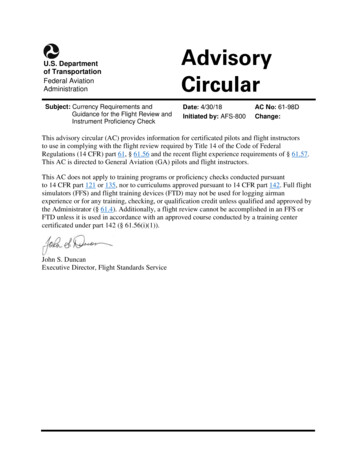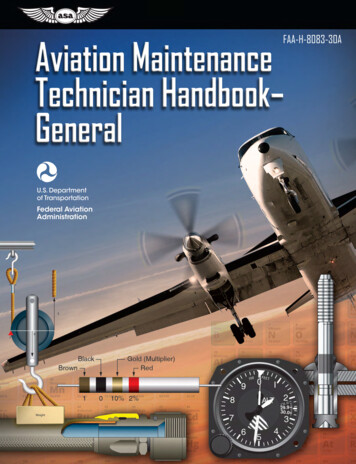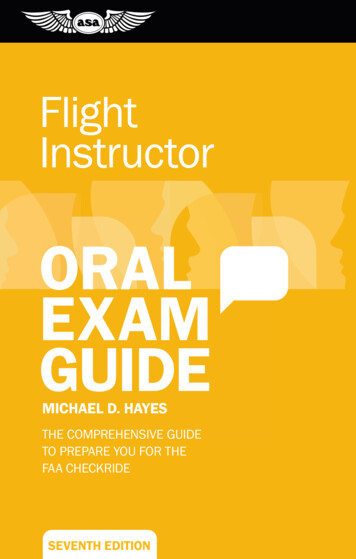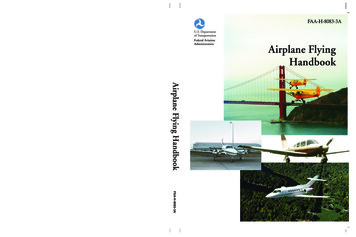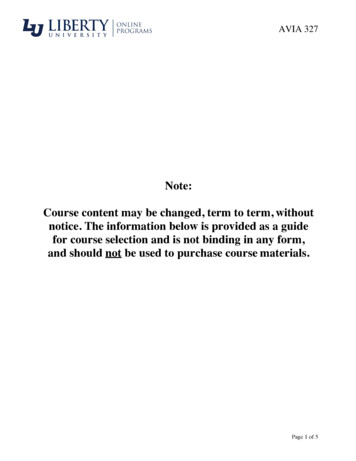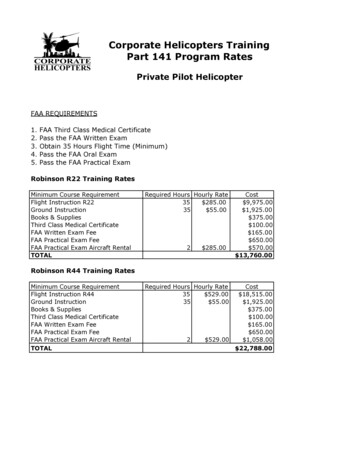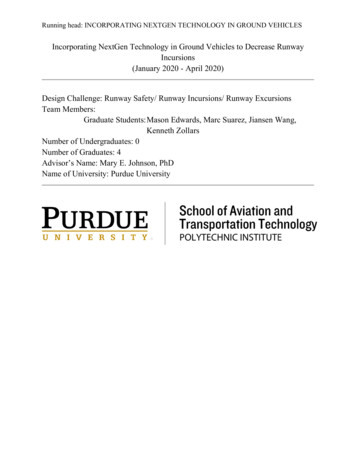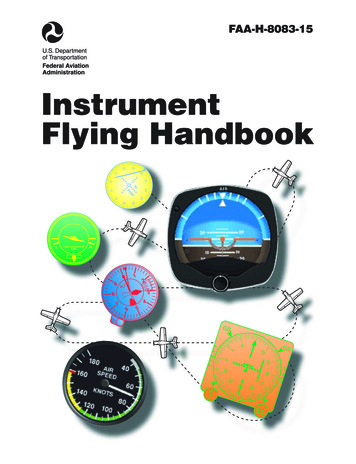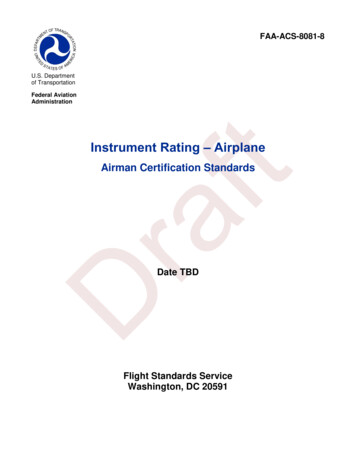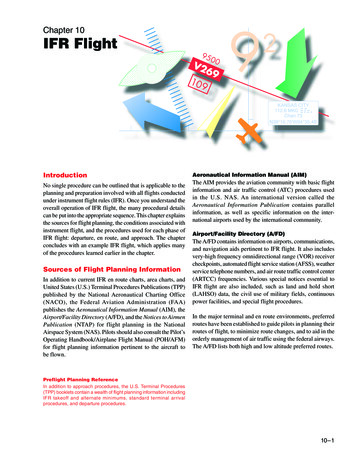
Transcription
Chapter 10IFR FlightIntroductionNo single procedure can be outlined that is applicable to theplanning and preparation involved with all flights conductedunder instrument flight rules (IFR). Once you understand theoverall operation of IFR flight, the many procedural detailscan be put into the appropriate sequence. This chapter explainsthe sources for flight planning, the conditions associated withinstrument flight, and the procedures used for each phase ofIFR flight: departure, en route, and approach. The chapterconcludes with an example IFR flight, which applies manyof the procedures learned earlier in the chapter.Sources of Flight Planning InformationIn addition to current IFR en route charts, area charts, andUnited States (U.S.) Terminal Procedures Publications (TPP)published by the National Aeronautical Charting Office(NACO), the Federal Aviation Administration (FAA)publishes the Aeronautical Information Manual (AIM), theAirport/Facility Directory (A/FD), and the Notices to AirmenPublication (NTAP) for flight planning in the NationalAirspace System (NAS). Pilots should also consult the Pilot’sOperating Handbook/Airplane Flight Manual (POH/AFM)for flight planning information pertinent to the aircraft tobe flown.Aeronautical Information Manual (AIM)The AIM provides the aviation community with basic flightinformation and air traffic control (ATC) procedures usedin the U.S. NAS. An international version called theAeronautical Information Publication contains parallelinformation, as well as specific information on the international airports used by the international community.Airport/Facility Directory (A/FD)The A/FD contains information on airports, communications,and navigation aids pertinent to IFR flight. It also includesvery-high frequency omnidirectional range (VOR) receivercheckpoints, automated flight service station (AFSS), weatherservice telephone numbers, and air route traffic control center(ARTCC) frequencies. Various special notices essential toIFR flight are also included, such as land and hold short(LAHSO) data, the civil use of military fields, continuouspower facilities, and special flight procedures.In the major terminal and en route environments, preferredroutes have been established to guide pilots in planning theirroutes of flight, to minimize route changes, and to aid in theorderly management of air traffic using the federal airways.The A/FD lists both high and low altitude preferred routes.Preflight Planning ReferenceIn addition to approach procedures, the U.S. Terminal Procedures(TPP) booklets contain a wealth of flight planning information includingIFR takeoff and alternate minimums, standard terminal arrivalprocedures, and departure procedures.10–1
Notices to Airmen Publication (NTAP)The NTAP is a publication containing current Notices toAirmen (NOTAMs) which are essential to the safety of flight,as well as supplemental data affecting the other operationalpublications listed. It also includes current Flight Data Center(FDC) NOTAMs, which are regulatory in nature, issued toestablish restrictions to flight or to amend charts or publishedinstrument approach procedures (IAPs).POH/AFMThe POH/AFM contain operating limitations, performance,normal and emergency procedures, and a variety of otheroperational information for the respective aircraft. Aircraftmanufacturers have done considerable testing to gather andsubstantiate the information in the aircraft manual. Pilotsshould refer to it for information relevant to a proposed flight.A review of the contents of all the publications listed willhelp you determine which material should be referenced foreach flight and those you would consult less frequently. Asyou become more familiar with these publications, you willbe able to plan your IFR flights quickly and easily.IFR Flight PlanAs specified in Title 14 of the Code of Federal Regulations(14 CFR) part 91, no person may operate an aircraft incontrolled airspace under IFR unless that person has filedan IFR flight plan. Flight plans may be submitted to thenearest AFSS or air traffic control tower (ATCT) either inperson, by telephone (1-800-WX-BRIEF), by computer(using the direct user access terminal system (DUATS)), orby radio if no other means are available. Pilots should fileFigure 10-1. Flight plan form.Controlled airspace: An airspace ofdefined dimensions within whichATC service is provided to IFR andvisual flight rules (VFR) flights inaccordance with the airspaceclassification. Includes Class A, ClassB, Class C, Class D, and Class Eairspace.10–2
IFR flight plans at least 30 minutes prior to estimated timeof departure to preclude possible delay in receiving a departure clearance from ATC. The AIM provides guidancefor completing and filing FAA Form 7233-1, Flight Plan.These forms are available at flight service stations (FSS’s),and are generally found in flight planning rooms at airportterminal buildings. [Figure 10-1]Filing in FlightIFR flight plans may be filed from the air under variousconditions, including:1. A flight outside of controlled airspace before proceedinginto IFR conditions in controlled airspace.2. A VFR flight expecting IFR weather conditions en routein controlled airspace.In either of these situations, the flight plan may be filed withthe nearest AFSS or directly with the ARTCC. A pilot whofiles with the AFSS submits the information normally enteredduring preflight filing, except for “point of departure,” togetherwith present position and altitude. AFSS then relays thisinformation to the ARTCC. The ARTCC will then clear thepilot from present position or from a specified navigation fix.your IFR flight plan within areas such as Class C or Class Bairspace.If you are operating on an IFR flight plan to an airport withan operating control tower, your flight plan is canceledautomatically upon landing. If you are operating on an IFRflight plan to an airport without an operating control tower,you must cancel the flight plan. This can be done by telephoneafter landing if there is no operating FSS, or other means ofdirect communications with ATC. If there is no FSS and airto-ground communications with ATC are not possible belowa certain altitude, you may cancel your IFR flight plan whilestill airborne and able to communicate with ATC by radio. Ifyou follow this procedure, be certain the remainder of yourflight can be conducted under VFR. It is essential that youcancel your IFR flight plan expeditiously. This allows otherIFR traffic to utilize the airspace.ClearancesAn ATC clearance allows an aircraft to proceed underspecified traffic conditions within controlled airspace for thepurpose of providing separation between known aircraft.ExamplesA pilot who files direct with the ARTCC reports presentposition and altitude, and submits only the flight planinformation normally relayed from the AFSS to the ARTCC.Be aware that traffic saturation frequently prevents ARTCCpersonnel from accepting flight plans by radio. In such cases,you will be advised to contact the nearest AFSS to file yourflight plan.Canceling IFR Flight PlansYou may cancel your IFR flight plan any time you areoperating in VFR conditions outside Class A airspace bystating “cancel my IFR flight plan” to the controller or airto-ground station with which you are communicating. Aftercanceling your IFR flight plan, you should change to theappropriate air-to-ground frequency, appropriate transpondercode as directed, and VFR altitude/flight level.ATC separation and information services (including radarservices, where applicable) are discontinued. If you desireVFR radar advisory service, you must specifically requestit. Be aware that other procedures may apply if you cancelA flight filed for a short distance at a relatively low altitudein an area of low traffic density might receive a clearance asfollows:“Cessna 1230 Alpha, cleared to Doeville airport direct,cruise 5,000.”The term “cruise” in this clearance means you are authorizedto fly at any altitude from the minimum IFR altitude up toand including 5,000 feet. You may level off at any altitudewithin this block of airspace. A climb or descent within theblock may be made at your discretion. However, once youhave reported leaving an altitude within the block, you maynot return to that altitude without further ATC clearance.When ATC issues a cruise clearance in conjunction with anunpublished route, an appropriate crossing altitude will bespecified to ensure terrain clearance until the aircraft reachesa fix, point, or route where the altitude information is available. The crossing altitude ensures IFR obstruction clearanceto the point at which the aircraft enters a segment of apublished route or IAP.Clearance: Allows an aircraft toproceed under specified trafficconditions within controlledairspace, for the purpose ofproviding separation betweenknown aircraft.Cruise clearance: Used in an ATCclearance to allow a pilot to conductflight at any altitude from theminimum IFR altitude up to andincluding the altitude specified in theclearance. Also authorizes a pilot toproceed to and make an approach atthe destination airport.10–3
Once a flight plan is filed, ATC will issue the clearance withappropriate instructions, such as the following:“Cessna 1230 Alpha is cleared to Skyline airport via theCrossville 055 radial, Victor 18, maintain 5,000.Clearance void if not off by 1330.”You may receive a more complex clearance, such as:“Cessna 1230 Alpha is cleared to Wichita Mid-continentairport via Victor 77, left turn after takeoff, proceed directto the Oklahoma City VORTAC. Hold west on theOklahoma City 277 radial, climb to 5,000 in holdingpattern before proceeding on course. Maintain 5,000 toCASHION intersection. Climb to and maintain 7,000.Departure control frequency will be 121.05. Squawk0412.”Suppose you are awaiting departure clearance at a busymetropolitan terminal (your first IFR departure from thisairport). On an average day, the tower at this airport controlsdepartures at a rate of one every 2 minutes to maintain therequired traffic flow. Sequenced behind you are a number ofaircraft ready for departure, including jet transports.Clearance delivery may issue you the following “abbreviated clearance” which includes a departure procedure (DP):The DP enables you to study and understand the details ofyour departure before filing an IFR flight plan. It providesthe information necessary for you to set up your communication and navigation equipment and be ready fordeparture before requesting IFR clearance from the tower.Once the clearance is accepted, you are required to complywith ATC instructions. You may request a clearance differentfrom that issued if you consider another course of actionmore practicable or if your aircraft equipment limitations orother considerations make acceptance of the clearanceinadvisable.Pilots should also request clarification or amendment, asappropriate, any time a clearance is not fully understood orconsidered unacceptable because of safety of flight. The pilotis responsible for requesting an amended clearance if ATCissues a clearance that would cause a pilot to deviate from arule or regulation or would place the aircraft in jeopardy.Clearance SeparationsATC will provide the pilot on an IFR clearance with separation from other IFR traffic. This separation is provided:1. Vertically— by assignment of different altitudes.2. Longitudinally—by controlling time separation betweenaircraft on the same course.3. Laterally— by assignment of different flightpaths.“Cessna 1230 Alpha, cleared to La Guardia as filed,RINGOES 8 departure Phillipsburg transition, maintain8,000. Departure control frequency will be 120.4,Squawk 0700.”This clearance may be readily copied in shorthand as follows:“CAF RNGO8 PSB M80 DPC 120.4 SQ 0700.”The information contained in this DP clearance is abbreviated using clearance shorthand (see appendix 1). Youshould know the locations of the specified navigationfacilities, together with the route and point-to-point time,before accepting the clearance.4. By radar— including all of the above.ATC does not provide separation for an aircraft operating:1. Outside controlled airspace;2. On an IFR clearance:a. With “VFR-On-Top” authorized instead of a specificassigned altitude.b. Specifying climb or descent in “VFR conditions.”c. At any time in VFR conditions, since uncontrolled VFRflights may be operating in the same airspace.In addition to heading and altitude assignments, ATC willoccasionally issue speed adjustments to maintain the requiredseparations. For example:“Cessna 30 Alpha, slow to 100 knots.”Clearance delivery: Control towerposition responsible for transmittingdeparture clearances to IFR flights.10–4Departure procedure (DP):Preplanned IFR ATC departure/obstacle avoidance procedures,published for pilot use in textual andgraphic format.See and AvoidAn IFR clearance does not relieve the pilot in command of responsibility to see and avoid traffic while operating in visual conditions.
Pilots who receive speed adjustments are expected to maintain that speed plus or minus 10 knots. If for any reason thepilot is not able to accept a speed restriction, the pilot shouldadvise ATC.1. Pilots of IFR aircraft operating from locations where DPprocedures are effective may expect an ATC clearancecontaining a DP. The use of a DP requires pilot possessionof at least the textual description of the approved DP.At times, ATC may also employ visual separation techniquesto keep aircraft safely separated. A pilot who obtains visualcontact with another aircraft may be asked to maintain visualseparation or to follow the aircraft. For example:2. If you do not possess a preprinted DP or for any otherreason do not wish to use a DP, you are expected to adviseATC. Notification may be accomplished by filing “NODP” in the remarks section of the filed flight plan, or byadvising ATC.“Cessna 30 Alpha, maintain visual separation with thattraffic, climb and maintain 7,000.”3. If you accept a DP in your clearance, you must complywith it.The pilot’s acceptance of instructions to maintain visual separation or to follow another aircraft is an acknowledgmentthat he or she will maneuver the aircraft, as necessary, tomaintain safe separation. It is also an acknowledgment thatthe pilot accepts the responsibility for wake turbulenceavoidance.In the absence of radar contact, ATC will rely on positionreports to assist in maintaining proper separation. Using thedata transmitted by the pilot, the controller follows theprogress of your flight. ATC must correlate your reports withall the others to provide separation; therefore, the accuracyof your reports can affect the progress and safety of everyother aircraft operating in the area on an IFR flight plan.Departure Procedures (DPs)DPs are designed to expedite clearance delivery, to facilitatetransition between takeoff and en route operations, and toensure adequate obstacle clearance. They furnish pilots’departure routing clearance information in both graphic andtextual form. To simplify clearances, DPs have been established for the most frequently used departure routes in areasof high traffic activity. A DP will normally be used wheresuch departures are available, since this is advantageous toboth users and ATC. [Figure 10-2]DPs can be found in section C of each booklet publishedregionally by the NACO, TPP, along with “IFR Take-offMinimums.” The following points are important to rememberif you file IFR out of terminal areas where DPs are in use.Position report: A report over aknown location as transmitted by thepilot to ATC.TPP: Booklets published in regionalformat by the NACO that includeDPs, standard terminal arrivals(STARs), IAPs, and other informationpertinent to IFR flight.Radar Controlled DeparturesOn your IFR departures from airports in congested areas,you will normally receive navigational guidance fromdeparture control by radar vector. When your departure is tobe vectored immediately following takeoff, you will beadvised before takeoff of the initial heading to be flown. Thisinformation is vital in the event you experience a loss of twoway radio communications during departure.The radar departure is normally simple. Following takeoff,you contact departure control on the assigned frequency whenadvised to do so by the control tower. At this time departurecontrol verifies radar contact, and gives headings, altitude,and climb instructions to move you quickly and safely out ofthe terminal area. Fly the assigned headings and altitudesuntil the controller tells you your position with respect to theroute given in your clearance, whom to contact next, and to“resume your own navigation.”Departure control will vector you to either a navigation facility or an en route position appropriate to your departureclearance, or you will be transferred to another controllerwith further radar surveillance capabilities. [Figure 10-2]A radar controlled departure does not relieve you of yourresponsibilities as pilot in command. You should be preparedbefore takeoff to conduct your own navigation according toyour ATC clearance, with navigation receivers checked andproperly tuned. While under radar control, monitor yourinstruments to ensure that you are continuously oriented tothe route specified in your clearance, and record the timeover designated checkpoints.Obstacle AvoidanceWhen departing from airports without operating control towers in IFRconditions, adhere to the published obstacle departure procedure(DP), if applicable.10–5
10–6Figure 10-2. Departure procedure (DP).
Departures from Airports Withoutan Operating Control TowerWhen you are departing from airports that have neither anoperating tower nor an FSS, you should telephone your flightplan to the nearest ATC facility at least 30 minutes beforeyour estimated departure time. If weather conditions permit,you could depart VFR and request IFR clearance as soon asradio contact is established with ATC. If weather conditionsmake it undesirable to fly VFR, you could again telephoneand request clearance. In this case, the controller wouldprobably issue a short-range clearance pending establishmentof radio contact, and might restrict your departure time to acertain period. For example:“Clearance void if not off by 0900.”This would authorize you to depart within the allotted periodand proceed in accordance with your clearance. In the absenceof any specific departure instructions, you would be expectedto proceed on course via the most direct route.In each report, pilots are expected to include aircraft identification, equipment affected, and degree to which IFRoperational capability in the ATC system is impaired. Thenature and extent of assistance desired from ATC must alsobe stated.Position ReportsUnless in radar contact with ATC, you are required to furnisha position report over certain reporting points. Position reportsare required over each compulsory reporting point (shownon the chart as solid triangle figures) along the routebeing flown regardless of altitude, including those with aVFR-On-Top clearance. Along direct routes, reports arerequired of all IFR flights over each point used to define theroute of flight. Reports at reporting points (shown as opentriangle figures) are made only when requested by ATC.Position reports should include the following items:1. Identification.2. Position.En Route Procedures3. Type of flight plan, if your report is made to an AFSS.Procedures en route will vary according to the proposed route,the traffic environment, and the ATC facilities controllingthe flight. Some IFR flights are under radar surveillance andcontrolled from departure to arrival and others rely entirelyon pilot navigation.4. The estimated time of arrival (ETA) over next reportingpoint.5. The name only of the next succeeding (required) reportingpoint along the route of flight.6. Pertinent remarks.Where ATC has no jurisdiction, it does not issue an IFR clearance. It has no control over the flight; nor does the pilot haveany assurance of separation from other traffic.ATC ReportsEn route position reports are submitted normally to theARTCC controllers via direct controller-to-pilot communications channels, using the appropriate ARTCC frequencieslisted on the en route chart.All pilots are required to report unforecast weather conditionsor other information related to safety of flight to ATC. Pilotsof aircraft operated in controlled airspace under IFR, are alsorequired to immediately report to ATC any of the followingequipment malfunctions occurring in flight:Whenever an initial Center contact is to be followed by aposition report, the name of the reporting point should beincluded in the callup. This alerts the controller that suchinformation is forthcoming. For example:1. Loss of VOR, tactical air navigation (TACAN) or automatic direction finder (ADF) receiver capability.2. Complete or partial loss of instrument landing system(ILS) receiver capability.“Cleveland Center, Cessna 1230 Alpha at HARWLintersection.”3. Impairment of air-to-ground communications capability.VFR DeparturesWhen departing VFR to receive an IFR clearance airborne, considerobstacle clearance, airspace, VFR cloud clearance requirements, andan alternate plan of action if an IFR clearance cannot be received.10–7
Additional ReportsIn addition to other required reports, the following reportsshould be made to ATC:1. When vacating any previously assigned altitude or flightlevel (FL) for a newly assigned altitude or FL.2. When an altitude change will be made, when operatingon a VFR-On-Top clearance.3. When an approach has been missed (request clearancefor specific action (e.g., to altermate airport, anotherapproach, etc.)).(The following reports are not required if in radar contactwith ATC:)4. The time and altitude or FL reaching a holding fix orpoint to which cleared.5. When leaving any assigned holding fix or point.6. When leaving final approach fix (FAF) inbound on finalapproach.7. A corrected estimate at any time it becomes apparent thatan estimate previously submitted is in error in excess of3 minutes.Planning the Descent and ApproachATC arrival procedures and cockpit workload are affectedby weather conditions, traffic density, aircraft equipment, andradar availability.When landing at airports with approach control services andwhere two or more IAPs are published, you will be providedin advance of arrival with information on the type of approachto expect or if you will be vectored for a visual approach.This information will be broadcast either on automatedterminal information service (ATIS) or by a controller. It willnot be furnished when the visibility is 3 miles or better andthe ceiling is at or above the highest initial approach altitudeestablished for any low altitude IAP for the airport.The purpose of this information is to help you in planningarrival actions; however, it is not an ATC clearance or commitment and is subject to change. Fluctuating weather, shiftingwinds, blocked runway, etc., are conditions that may resultin changes to the approach information you previouslyreceived. It is important to advise ATC immediately if youare unable to execute the approach, or if you prefer, anothertype of approach.If the destination is an airport without an operating controltower, and has automated weather data with broadcastcapability, you should monitor the automated surfaceobserving system/automated weather observing system(ASOS/AWOS) frequency to ascertain the current weatherfor the airport. You should advise ATC once you have receivedthe broadcast weather and state your intentions.Once you know which approach you will execute, you shouldplan for the descent prior to the initial approach fix (IAF) ortransition route depicted on the IAP. When flying thetransition route, maintain the last assigned altitude until youhear “cleared for the approach” and have intercepted asegment of the approach. You may “request lower” to bringyour transition route closer to the required altitude for theinitial approach altitude. When ATC uses the phrase, “atpilot’s discretion” in the altitude information of a clearance,you have the option to start a descent at any rate, and youmay level off temporarily at any intermediate altitude.However, once you have vacated an altitude, you may notreturn to that altitude. When ATC has not used the term “atpilot’s discretion” nor imposed any descent restrictions, youshould initiate descent promptly upon acknowledgment ofthe clearance.Descend at an optimum rate (consistent with the operatingcharacteristics of the aircraft) to 1,000 feet above the assignedaltitude. Then attempt to descend at a rate of between 500and 1,500 feet per minute (fpm) until the assigned altitude isreached. If at anytime you are unable to descend at a rate ofat least 500 fpm, advise ATC. Advise ATC if it is necessaryto level off at an intermediate altitude during descent. Anexception to this is when leveling off at 10,000 feet meansea level (MSL) on descent, or 2,500 feet above airportelevation (prior to entering a Class B, Class C, or Class Dsurface area) when required for speed reduction.Standard Terminal Arrival Routes (STARs)Standard terminal arrival routes (as described in Chapter8) have been established to simplify clearance deliveryprocedures for arriving aircraft at certain areas having highdensity traffic. A STAR serves a purpose parallel to that of aDP for departing traffic. [Figure 10-3] The following pointsregarding STARs are important to remember:1. All STARs are contained in the TPP, along with the IAPcharts for your destination airport. The AIM also describesSTAR procedures.Standard terminal arrival route(STAR): A preplanned IFR ATCarrival procedure published for pilotuse in graphic and/or textual form.10–8
Figure 10-3. Standard terminal arrival route (STAR).10–9
2. If your destination is a location for which STARs havebeen published, you may be issued a clearance containinga STAR whenever ATC deems it appropriate. You mustpossess at least the approved textual description.3. It is your responsibility to either accept or refuse an issuedSTAR. If you do not wish to use a STAR, you shouldadvise ATC by placing “NO STAR” in the remarks sectionof your filed flight plan or by advising ATC.4. If you accept a STAR in your clearance, you must complywith it.further clearance from ATC. A standard holding pattern usesright turns, and a nonstandard holding pattern uses left turns.The ATC clearance will always specify left turns when anonstandard pattern is to be flown.Standard Holding Pattern (No Wind)The standard holding pattern is a racetrack pattern. [Figure10-4] The aircraft follows the specified course inbound tothe holding fix, turns 180 to the right, flies a parallel straightcourse outbound for 1 minute, turns 180 to the right, andflies the inbound course to the fix.Substitutes for Inoperative or UnusableComponentsThe basic ground components of an ILS are the localizer,glide slope, outer marker, middle marker, and inner marker(when installed). A compass locator or precision radar maybe substituted for the outer or middle marker. Distancemeasuring equipment (DME), VOR, or nondirectional beacon(NDB) fixes authorized in the standard IAP or surveillanceradar may be substituted for the outer marker.Additionally, IFR-certified global positioning system (GPS)equipment, operated in accordance with Advisory Circular(AC) 90-94, Guidelines for Using Global Positioning SystemEquipment for IFR En Route and Terminal Operations andfor Nonprecision Instrument Approaches in the U.S. NAS,may be substituted for ADF and DME equipment, except forwhen flying NDB IAP. Specifically, GPS can be substitutedfor ADF and DME equipment when:1. Flying a DME arc;2. Navigating TO/FROM an NDB;3. Determining the aircraft position over an NDB;4. Determining the aircraft position over a fix made up of acrossing NDB bearing;5. Holding over an NDB;6. Determining aircraft position over a DME fix.Figure 10-4. Standard holding pattern—no wind.Standard Holding Pattern (With Wind)In compliance with the holding pattern procedures given inthe AIM, the symmetrical racetrack pattern cannot be trackedwhen a wind exists. Pilots are expected to:1. Compensate for the effect of a known wind except whenturning.2. Adjust outbound timing so as to achieve a 1-minute(1-1/2 minutes above 14,000 feet) inbound leg.Figure 10-5 illustrates the holding track followed with a leftcrosswind. The effect of wind is counteracted by applyingdrift corrections to the inbound and outbound legs and byapplying time allowances to the outbound leg.Holding ProceduresDepending upon traffic and weather conditions, holding maybe required. Holding is a predetermined maneuver whichkeeps aircraft within a specified airspace while awaitingCompass locator: A low-power,low- or medium-frequency (L/MF)radio beacon installed at the site ofthe outer or middle marker of an ILS.10–10Holding: A predetermined maneuverthat keeps aircraft within a specifiedairspace while awaiting furtherclearance from ATC.Standard holding pattern: Aholding pattern in which all turns aremade to the right.
3. Radial, course, bearing, airway, or route on which theaircraft is to hold.4. Leg length in miles if DME or area navigation (RNAV)is to be used (leg length will be specified in minutes onpilot request or if the controller considers it necessary).5. Direction of turn if left turns are to be made, the pilotrequests or the controller considers it necessary.6. Time to expect-further-clearance (EFC) and any pertinent additional delay information.ATC instructions will also be issued whenever:1. It is determined that a delay will exceed 1 hour.2. A revised EFC is necessary.3. In a terminal area having a number of navigation aidsand approach procedures, a clearance limit may notindicate clearly which approach procedures will be used.On initial contact, or as soon as possible thereafter,approach control will advise you of the type of approachyou may
for completing and filing FAA Form 7233-1, Flight Plan. These forms are available at flight service stations (FSS's), and are generally found in flight planning rooms at airport terminal buildings. [Figure 10-1] Filing in Flight IFR flight plans may be filed from the air under various conditions, including: 1.
